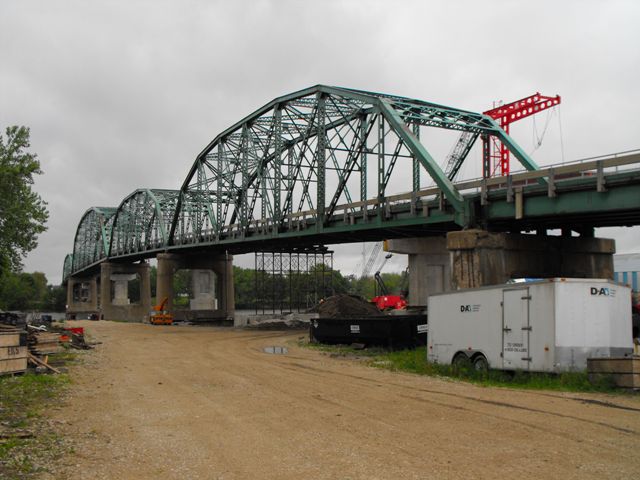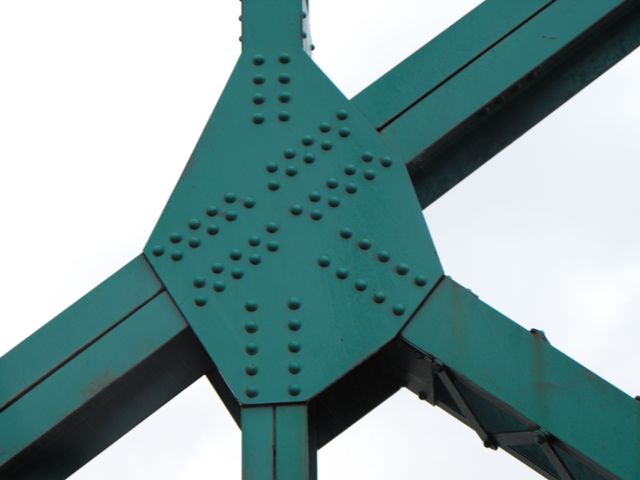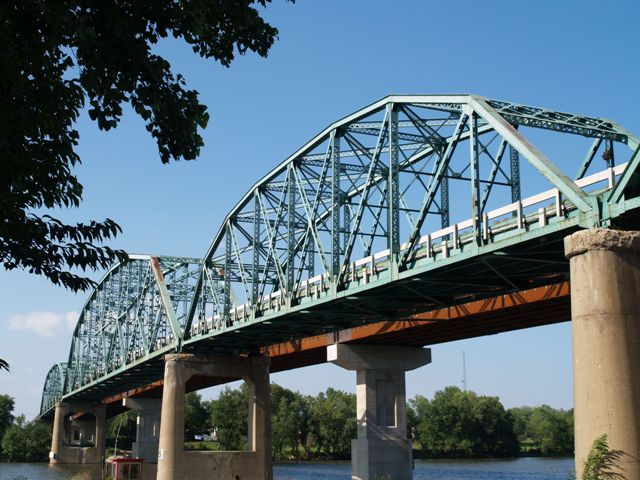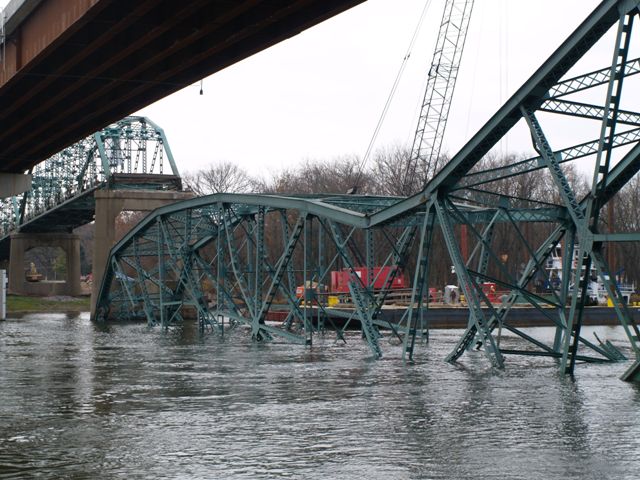We Recommend:
Bach Steel - Experts at historic truss bridge restoration.
Seneca Bridge
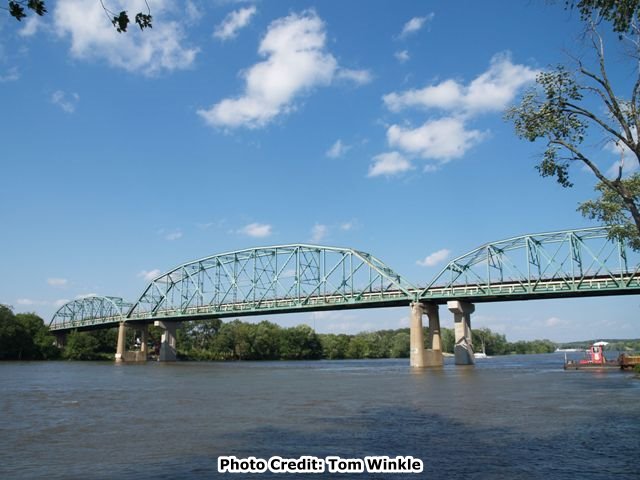
Primary Photographer(s): Nathan Holth and Rick McOmber
Bridge Documented: May 8, 2010
Seneca: La Salle County, Illinois: United States
1932 By Builder/Contractor: Wisconsin Bridge and Iron Company of Milwaukee, Wisconsin
1986
364.0 Feet (110.9 Meters)
1,510.0 Feet (460.2 Meters)
23 Feet (7.01 Meters)
4 Main Span(s) and 9 Approach Span(s)
50007011387

View Information About HSR Ratings
Bridge Documentation
This bridge no longer exists!
This bridge's song is:
View Archived National Bridge Inventory Report - Has Additional Details and Evaluation
View The Original Plans For This Historic Bridge (4.6mb PDF)
View The 1985 Rehabilitation Plans For This Historic Bridge (85mb PDF)
This landmark historic bridge was demolished by Illinois Department of Transportation November 18, 2010 at 7:05 AM EST
The Seneca Bridge was a magnificent example of a large simple-spanning metal truss bridge constructed in the later period of the truss bridge era. The bridge was historically significant for its large 364 foot channel span that also displayed the uncommon Pennsylvania truss configuration. It was also noteworthy for its large overall length in excess of 1000 feet. The bridge also had good historic integrity for a bridge of its size. The bridge was also locally significant for its high level of aesthetic value, function as a recognizable local landmark, and for its gateway function as a visible and impressive entry and exit into the city of Seneca. The Seneca website even displayed a logo with a stylized depiction of the bridge. Now that this historic bridge has been demolished, Seneca no longer has a signature historic bridge to identify the community. Seneca will need to remove this depiction from the logo and replace it was a simple line, to represent the plain and ugly bridge that has been built at this location.
Large metal truss bridges such as the Seneca Bridge are among the most threatened of historic bridge types in the country. Because fewer large bridges tend to be built than smaller bridges (due to cost and number of obstacles large enough to warrant large bridges) there are fewer such bridges in existence to begin with. Further, because larger obstacles like the Illinois River have less crossings than smaller obstacles, each bridge tends to be further apart from each other which means the Average Daily Traffic and truck counts are higher. Therefore, these bridges experience a high risk for replacement.
Up until the 21st Century, the Illinois River in its entirety contained an unusually complete group of these large and significant historic metal truss bridges including simple-span truss bridges such as the Seneca Bridge, as well as cantilever truss bridges and movable bridges. This continuity would appear to have been thanks to a strong commitment on the part of IDOT to maintain and rehabilitate these historic bridges. However, recently their seems to have been a change for the worst on the part of IDOT, which is most unfortunate. Today, the continuity of this group is severely threatened as IDOT appears to have its mind set on demolishing these historic bridges one by one. The first bridge to be demolished in the region was the Marseilles Bridge. According to Gary Sprandel, "The Marseilles bridge was similar to the Seneca bridge except for all the spans were the smaller type with no larger "main channel" span. Since the river at Marseilles is shallow with rapids and a very solid rock bed a shipping canal was built just south of the actual river. The bridge had 3 spans rising at a fairly steep angle over the river with a small space at the "island" between the river and canal with forth span crossing the canal level at a height to clear river traffic and then a concrete railed south approach span with a slight S curve to align with the road that was on the alignment of the first river bridge."
The second in the region to go to the scrapyard was the nearby Morris Bridge in 2002, which was a similar structure to the Seneca Bridge. Next was this bridge, the beautiful historic Seneca Bridge. Both the Morris Bridge and the Seneca Bridge were replaced by modern bridges whose shear ugliness defies the human language. And coming soon to the chopping block is the Meredosia Bridge, a historic cantilever bridge a significant distance downstream.
Of particular concern with all these replacement projects is that fact that IDOT is demolishing these historic bridges despite that fact that the replacement bridges are built on new alignments next to the historic bridge. In other words, it would be possible to simply leave the historic bridge standing next to its replacement for non-motorized use. This wasteful phenomenon of needless demolition occurs throughout the United States but this does not justify the act. Usually, unfounded concerns about liability, and seriously flawed regulations on the part of other involved agencies such as the Coast Guard have led to these scenarios where a historic bridge is demolished just for the sake of wiping if off the face of the earth. The time for change is now. Bridges such as the Seneca Bridge should absolutely be left standing next to their replacements for non-motorized use, or even completely closed to traffic to stand as a historic ruin.
Finally, another problem with the replacement of this bridge is that IDOT did not provide an official page with news and information about the replacement of this bridge. Therefore, public awareness that this beautiful historic bridge was being replaced was reduced. Whether this was intentional or not on the part of IDOT, any highway agency should strive to provide as much transparency and public information as possible. Most DOTs provide dedicated project websites for the replacement of bridges with the size and importance of the Seneca Bridge.
Original and 1985 rehabilitation plans for this historic bridge were released to the public by IDOT as part of the bid letting package for the replacement of the bridge. HistoricBridges.org is proud to provide copies of these important historic records of the bridge, with links available at the top of this narrative.
The plaques had been stolen from the bridge at the time HistoricBridges.org documented the bridge. However, a rendering of the plaque was produced using the original plans for the bridge. The rendering appears below. Also, a photo of the plaques was later provided by IDOT also shown below.

![]()
Photo Galleries and Videos: Seneca Bridge
Structure Overview
Original / Full Size PhotosA collection of overview photos that show the bridge as a whole and general areas of the bridge. This gallery offers photos in the highest available resolution and file size in a touch-friendly popup viewer.
Alternatively, Browse Without Using Viewer
![]()
Structure Details
Original / Full Size PhotosA collection of detail photos that document the parts, construction, and condition of the bridge. This gallery offers photos in the highest available resolution and file size in a touch-friendly popup viewer.
Alternatively, Browse Without Using Viewer
![]()
Sunny Summer 2010 Photos By Tom Winkle
Original / Full Size PhotosA collection of detail photos that document the parts, construction, and condition of the bridge. This gallery offers photos in the highest available resolution and file size in a touch-friendly popup viewer.
Alternatively, Browse Without Using Viewer
![]()
Demolition
Original / Full Size PhotosPhotos showing the demolition. This gallery offers photos in the highest available resolution and file size in a touch-friendly popup viewer.
Alternatively, Browse Without Using Viewer
![]()
Structure Overview
Mobile Optimized PhotosA collection of overview photos that show the bridge as a whole and general areas of the bridge. This gallery features data-friendly, fast-loading photos in a touch-friendly popup viewer.
Alternatively, Browse Without Using Viewer
![]()
Structure Details
Mobile Optimized PhotosA collection of detail photos that document the parts, construction, and condition of the bridge. This gallery features data-friendly, fast-loading photos in a touch-friendly popup viewer.
Alternatively, Browse Without Using Viewer
![]()
Sunny Summer 2010 Photos By Tom Winkle
Mobile Optimized PhotosA collection of overview photos that show the bridge as a whole and general areas of the bridge. This gallery features data-friendly, fast-loading photos in a touch-friendly popup viewer.
Alternatively, Browse Without Using Viewer
![]()
Demolition
Mobile Optimized PhotosPhotos showing the demolition. This gallery features data-friendly, fast-loading photos in a touch-friendly popup viewer.
Alternatively, Browse Without Using Viewer
![]()
Maps and Links: Seneca Bridge
This historic bridge has been demolished. This map is shown for reference purposes only.
Coordinates (Latitude, Longitude):
Search For Additional Bridge Listings:
Bridgehunter.com: View listed bridges within 0.5 miles (0.8 kilometers) of this bridge.
Bridgehunter.com: View listed bridges within 10 miles (16 kilometers) of this bridge.
Additional Maps:
Google Streetview (If Available)
GeoHack (Additional Links and Coordinates)
Apple Maps (Via DuckDuckGo Search)
Apple Maps (Apple devices only)
Android: Open Location In Your Map or GPS App
Flickr Gallery (Find Nearby Photos)
Wikimedia Commons (Find Nearby Photos)
Directions Via Sygic For Android
Directions Via Sygic For iOS and Android Dolphin Browser
USGS National Map (United States Only)
Historical USGS Topo Maps (United States Only)
Historic Aerials (United States Only)
CalTopo Maps (United States Only)



